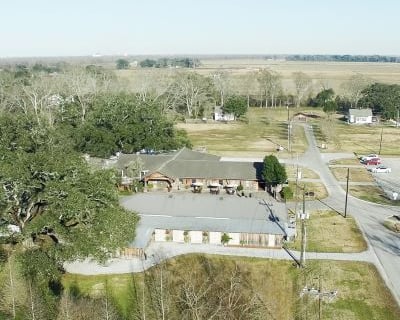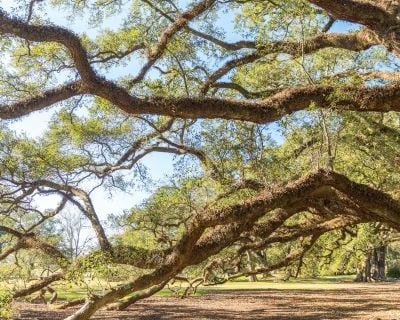A Visitor's Guide to Exploring Oak Alley Plantation: History, Beauty, and Insights
Visiting Oak Alley Plantation offers a profound experience that transcends mere sightseeing; it is an invitation to engage with the rich tapestry of history, architecture, and nature. The iconic alley of oaks, towering and majestic, serves as a poignant reminder of the plantation's storied past and the lives intertwined within its grounds. Each step along the tree-lined pathway encourages reflection on the complexities of its history, encompassing the beauty and struggles that shaped this remarkable site.
UNITED STATESLOUISIANAOUTDOOR ACTIVITIES
12/30/20249 min read
DISCLOSURE:
There may be affiliate links on this post. If you buy something using these links i may receive a small commission at zero cost to you.
Introduction to Oak Alley Plantation
Oak Alley Plantation, a renowned historical site located along the banks of the Mississippi River in Vacherie, Louisiana, stands as a testament to the grandeur of the antebellum South. Established in the early 19th century, the plantation spans 25 acres and is named after its striking alley lined with majestic live oak trees, which are estimated to be around 300 years old. These towering trees create a breathtaking canopied approach to the main house, inviting visitors to experience a unique blend of natural beauty and architectural elegance.
At the heart of the plantation lies the beautifully restored Greek Revival mansion, completed in 1839. Its white-columned façade reflects the architectural trends of the period, showcasing intricate craftsmanship and design that attracted the attention of wealthy plantation owners. The house itself is a symbol of the agricultural prosperity stemming from the sugarcane plantations in the region. Visitors to Oak Alley Plantation can explore the meticulously maintained grounds and the breathtaking views that exemplify the Southern landscape.
The historical significance of Oak Alley Plantation extends beyond its aesthetic appeal; it is a poignant reminder of Louisiana’s complex past, encompassing the legacies of both wealth and slavery. The plantation provides educational experiences that highlight the lives of those who lived and worked here, further immersing guests in the region's rich cultural heritage. Through guided tours and informative displays, visitors can gain insights into the social and economic dynamics that characterized plantation life in the 19th century.
As guests stroll the lush gardens and experience the grandeur of the estate, they are invited to reflect on the interplay of history and beauty, making Oak Alley Plantation a must-visit destination for those seeking to connect with the timeless stories of the South.
The Historical Significance of Oak Alley
Oak Alley Plantation, located along the banks of the Mississippi River in Louisiana, serves as a poignant reminder of the antebellum South's complex history. Founded in 1839 by Jacques and Celina Roman, the plantation was established on a sprawling land base known for its fertile soil, making it an ideal location for cultivating sugarcane and cotton. The plantation's name is derived from the majestic live oak trees that line the historic alley leading up to the mansion, which were already over 100 years old at the time of the plantation's establishment.
Cotton emerged as a crucial cash crop in the South, driving the economy and shaping societal structures. At its zenith, the Oak Alley Plantation was emblematic of the agricultural wealth produced by slave labor. Enslaved Africans and their descendants formed the backbone of the plantation's operations, enduring immense hardships to sustain its burgeoning economy. A deep understanding of this tragic era is essential for visitors who seek to comprehend the profound societal implications that ensued from this exploitation.
The legacy of Oak Alley Plantation also resonates through the stories of the people who lived and worked there. The plantation passed through multiple generations, each contributing to its intricate narrative. While the grandeur of the plantation's architecture and the beauty of its natural surroundings captivate visitors, it is essential to recognize the often-overlooked experiences of the enslaved individuals who toiled diligently within its bounds. Guided tours provide insights into these lives, offering a holistic view of the plantation's multifaceted history.
Understanding the historical significance of Oak Alley enriches the visitor experience, allowing for a deeper appreciation of both its aesthetic beauty and its troubling past. Every tour not only reveals the architectural and natural splendor of this location but also serves as a bridge to the critical discussions surrounding the impact of slavery, the cotton industry, and their enduring legacy in American culture.
Architectural Marvels: The Design of the Plantation House
Oak Alley Plantation stands as an exquisite representation of Greek Revival architecture, reflecting the design principles and aesthetic ideals prominent in the 19th century. Constructed in the early 1830s, the plantation house showcases the remarkable craftsmanship and lavish style that characterize this architectural movement. The grandeur of its design is immediately evident with its imposing façade, marked by towering columns that provide a striking entrance, ushering visitors into a realm of historical elegance.
The plantation's design features a symmetrical layout, a hallmark of Greek Revival style, whereby the structure is meticulously proportioned. The house is a two-story structure, crowned with a distinctive gabled roof that further emphasizes its classical influences. A wide, inviting porch stretches across the front, adorned with detailed woodwork that highlights the skill of the artisans who crafted it. The interplay of light and shadow on the façade invites observers to appreciate the meticulous details, from the window moldings to the classical pediments above the doors.
Inside, visitors will find expansive rooms characterized by high ceilings and large windows, allowing natural light to permeate the elegant interiors. The grand staircase serves as a central feature, with beautifully crafted banisters that embody the attention to detail prevalent in its construction. Throughout the house, intricate plasterwork and ornate furnishings further illustrate the opulence that defined the lifestyle of the plantation’s owners. The design not only reflects an era of wealth and sophistication but also serves as a testament to the vision of its creators, whose desire for beauty and grandeur is palpable in every aspect of the home. Thus, as visitors explore Oak Alley Plantation, they are invited to appreciate not just its historical significance, but also the stunning architectural legacy that endures through the years.
Stunning Landscapes and Iconic Oak Alleys
The Oak Alley Plantation, often celebrated for its breathtaking natural beauty, is distinguished by its iconic alleys of majestic oak trees. These trees, known for their robust size and sprawling canopies, form a picturesque corridor welcoming visitors to the plantation. The picturesque landscape is accentuated by the symmetry created by these ancient oaks, estimated to be over 300 years old. Their presence not only enhances the visual appeal of the plantation but also serves as a reminder of the rich history embedded in the grounds.
The oaks are intricately woven into the narratives of the plantation's past, having stood sentinel over generations of families and witnessing pivotal moments in history. Known scientifically as Quercus virginiana, the southern live oaks are well-suited to the local climate and soil, contributing to their long life and impressive stature. These trees play a critical role in the ecosystem, providing shelter and sustenance to various species of birds and insects, which thrive in this lush environment.
Visitors are encouraged to take leisurely strolls along the canopy-covered pathways, where sunlight filters through the leaves creating a magical ambiance. This experience allows guests to soak in the tranquil environment and appreciate the rustic charm that defines the Oak Alley Plantation. The manicured gardens, adorned with colorful flowers and well-maintained lawns, complement the natural surroundings, enhancing the overall aesthetic appeal.
As part of the New Orleans Oak Alley Plantation tour, visitors should not miss the opportunity to pause and reflect under the expansive branches of these historic trees. The serenity and beauty of the oak alleys serve as a fitting introduction to the plantation's storied past, offering moments of contemplation amidst the enchanting landscape that is both timeless and captivating.
Engaging Insights: Guided Tours and Experiences
Visiting Oak Alley Plantation offers a thorough exploration of both its rich history and breathtaking architecture, amplified through various guided tours and specialized experiences. These tours cater to a diverse audience, enriching their understanding of plantation life and the intricate narratives woven into its fabric. Visitors can select from multiple options, including the classic guided tour, which provides a comprehensive overview of the estate's past, showcasing its stunning antebellum architecture and the majestic oak-lined pathway that lends the plantation its name.
The classic tour typically lasts about an hour, during which knowledgeable guides share captivating stories of the plantation's former inhabitants, as well as insights into the slave labor that sustained its operations. Guests are encouraged to engage with the historical context, providing a deeper appreciation for the complexities of plantation life. In addition, the tours offer a unique opportunity to view various rooms within the mansion, marveling at period furnishings and décor that reflect the elegance of the era.
For those seeking a more specialized experience, Oak Alley Plantation also offers themed tours that focus on specific aspects of history, such as the lives of enslaved individuals or the plantation's involvement in broader historical events. Educational programs are available as well, targeting students and history buffs alike. These interactive sessions facilitate discussions around challenging topics, fostering a sense of empathy and understanding among participants. Overall, Oak Alley Plantation serves as a dynamic site for learning, catering to a range of interests through its tours and experiences that embrace both the beauty of the setting and the depth of its historical significance.
Tips for Visitors: Making the Most of Your Tour
Planning a visit to Oak Alley Plantation can be a rewarding experience, rich with history and natural beauty. To ensure an enjoyable outing, it's essential to consider the best times to visit. The plantation is open year-round, with peak seasons typically from March to May and September to November. During these months, the weather is more favorable, allowing visitors to explore the picturesque grounds and enjoy guided tours comfortably. However, visiting during weekdays often results in smaller crowds, enhancing your overall experience.
What you wear is equally important for a pleasant visit. The plantation features significant outdoor space and requires a fair amount of walking. Comfortable, weather-appropriate clothing and sturdy footwear are recommended. In the warmer months, lightweight clothes and sun protection, such as hats and sunscreen, are necessary to safeguard against the southern sun. Be sure to check the weather forecast before your visit to prepare for any unexpected rain or temperature changes.
Preparation is key when participating in a tour. It's beneficial to book tickets in advance, especially during busy seasons, to avoid disappointment. Consider arriving early to enjoy the grounds at your leisure and participate in any special events or programs offered on-site. Familiarizing yourself with the plantation's history beforehand can enhance your understanding and appreciation of the artifacts and architecture you will encounter during your visit.
While at Oak Alley, visitors might also find interest in nearby attractions. For instance, a short drive can lead to other historic plantations in the region, such as Laura Plantation or Kleinpeter Farm. Exploring these additional sites provides a broader understanding of the area’s cultural heritage.
In conclusion, whether it's your first visit or a return trip, following these tips can ensure a memorable experience at Oak Alley Plantation. Understanding when to visit, what to wear, and how to engage with the surrounding attractions will help visitors make the most of their journey to this elegant representation of southern history.
Conclusion: Embracing the Legacy of Oak Alley Plantation
Visiting Oak Alley Plantation offers a profound experience that transcends mere sightseeing; it is an invitation to engage with the rich tapestry of history, architecture, and nature. The iconic alley of oaks, towering and majestic, serves as a poignant reminder of the plantation's storied past and the lives intertwined within its grounds. Each step along the tree-lined pathway encourages reflection on the complexities of its history, encompassing the beauty and struggles that shaped this remarkable site.
A visit to Oak Alley is not only about marveling at the stunning antebellum architecture and picturesque landscapes. It is an opportunity to gain insights into the cultural and historical narratives that have emerged from the plantation's legacy. The informative tours, knowledgeable guides, and thoughtfully curated exhibits allow visitors to appreciate the significance of Oak Alley beyond its visual appeal, fostering a deeper understanding of the societal implications tied to its operation in the 19th century.
As one walks through the stunning grounds, the impressions left by the beautiful surroundings and compelling stories can resonate long after the visit concludes. It serves as a platform for appreciating heritage preservation, reminding us of the importance of honoring the past while paving the way toward a more inclusive future. It becomes imperative for visitors to share their experiences and memories, extending the legacy of Oak Alley Plantation and ensuring that its rich history remains vibrant for generations to come.
Ultimately, Oak Alley Plantation stands as a symbol of resilience and elegance, inviting all who visit to not only absorb its beauty, but to actively engage in conversations about history, memory, and preservation. Each encounter with its legacy offers essential lessons, encouraging continued exploration and appreciation for this significant landmark.
Recommended Tours Related to New Orleans Oak Alley Plantation:














